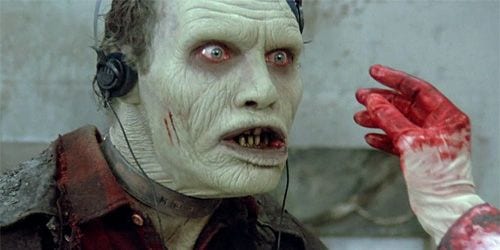
Recently Jonathan Franzen, one of America’s simultaneously most vaunted and belittled writers, carried on a well-worn tradition by decrying the alienation, narcissism and emptiness of the Internet age. He pilloried the Buzzfeed rhythm that has permeated into intellectual life.
For people younger than him, it’s easy to forget that relatively recently, America was an uglier place in many ways. Easy as it may be to malign the millennials, it’s almost certain that many tired old fights of the culture wars will die as the 20-somethings age. While we may avoid experiencing true sadness or joy by constantly looking at our phones, the Internet age has come with some checks on the basest of consumer tastes.
Case in point: Day of the Dead is shlock. But that doesn’t seem quite fair — shlock can be delightful. James Ellroy elevated the already very interesting pulp crime novel genre to, in the words of William Vollman in his New York Times review “A highly controlled work of art.” (“En Route to the Grassy Knoll”, William Vollman, February 26, 1995) The haunting white nothingness of Michael Meyers’ mask (actually William Shatner’s face turned inside out) reaches towards the mythical. Even corn syrup soaked slasher flicks like Last House on the Left promise some version of feminine triumph over patriarchal brutality. Day of the Dead feels like a film whose makers were aware of the possibility nascent in schlock horror, but didn’t have the vision or the wherewithal to put enough effort into it.
Thanatos, the ancient Greek word for death, is used in psychoanalytic circles to denote the Death Drive, which opposes Eros, the productive, sexual, creative or life affirming drive. The Pleasure Principle was a dominant theme in Freud’s earlier work. It’s basic premise being that human beings did what they could to maximize their pleasure and minimize unhappiness. This view became untenable in light of subjects which would repeat traumatic or unpleasant events from their past. Freud thus posited the Death Drive to explain people’s seemingly illogical behaviors that inhibit their own enjoyment.
Attendant to America’s obsession with vampire and zombie movies have been many critical pieces that understand the trend through Thanatos. While we may be experiencing a kind of death-drive zeitgeist at the moment, Day of the Dead does not jive with this trend. The theoretical framework of Thanatos implies a fairly troubling world view that basically says, You are naïve to think you will ever be satisfied by the objects of your desire; there will always be a remainder and therein lies the authentic, the Real. Day of the Dead doesn’t even provide a tantalizing object of desire, and thus has no hope of exposing desire’s veneer.
The film is glaringly a product of the ’80s. Leading the way is tough girl scientist-soldier Sarah (Lori Cardille). Somewhere between an ersatz Ellen Ripley and a shallower Lorie Strode, Sarah tries to find a cure for the epidemic of dead-eyed, illiterate droolers, while weathering the comically played-up harassment of military chief Rhodes (Joseph Pilato). They are boilerplate without the steam. Tropes tend to cover up the real grit behind social issues. Battles over feminine power are not usually fought between neanderthals and sexy geniuses.
This brings us to the escapism of the film. At its worst, cinema can be a means of disengaging. A good deal of films silence nagging anxiety and allow the viewer to be passively transported from thought for an hour and a half. This drive is paralleled in the apolitical stance common to many drug addicts. Yet good film doesn’t have to taste like medicine. Woody Allen can make urban isolation feel like a flirtatious jaunt.
Film should not make one disengage. The great irony here, if you can call it “great”, is that zombie films are supposed to be a send up of mindless consumer culture. Is it any surprise, then, that even resistance as mild as this was coopted and sold back to the people the genre was supposed to criticize? The Met had a punk rock gala. Vice magazine has a parody twitter, @Vice_is_hip that is almost indistinguishable from the genuine article.
It’s unclear when Hollywood decided that American viewers were lazy, though the belief was certainly gaining traction in the ’80s. Perhaps one contributing factor to short attention spans and the cancerous spread of disposable content is the deterioration of quality entertainment. This domain is no longer really the purview of films — it’s now the work of quality TV programming. There’s nothing wrong with enjoying Stephen King or Jim Thompson. While entertainment can incite moral anxiety or sneak in political questions, it doesn’t have to. There is value in pleasure itself. The trouble is, it turns out that it’s quite hard work, satisfying people’s desires.
ay of the Dead’s lazy attempts at sending up racism, sexism and consumerism betray the film’s obvious role as a product meant to distribute these sentiments because there was a market for them. Say what you will about their effect on our collective IQs, but at least bloggers might make producers nervous about reinforcing stereotypes that today’s youth culture is not interested in.
The DVD comes with the usual array of special features: an audio commentary with writer/director George A. Romero, behind the scenes footage from special makeup effects creator Tom Savini’s archive and a new documentary, World’s End: The Legacy of Day of the Dead, which is nothing to write home about.

![Call for Papers: All Things Reconsidered [MUSIC] May-August 2024](https://www.popmatters.com/wp-content/uploads/2024/04/all-things-reconsidered-call-music-may-2024-720x380.jpg)



